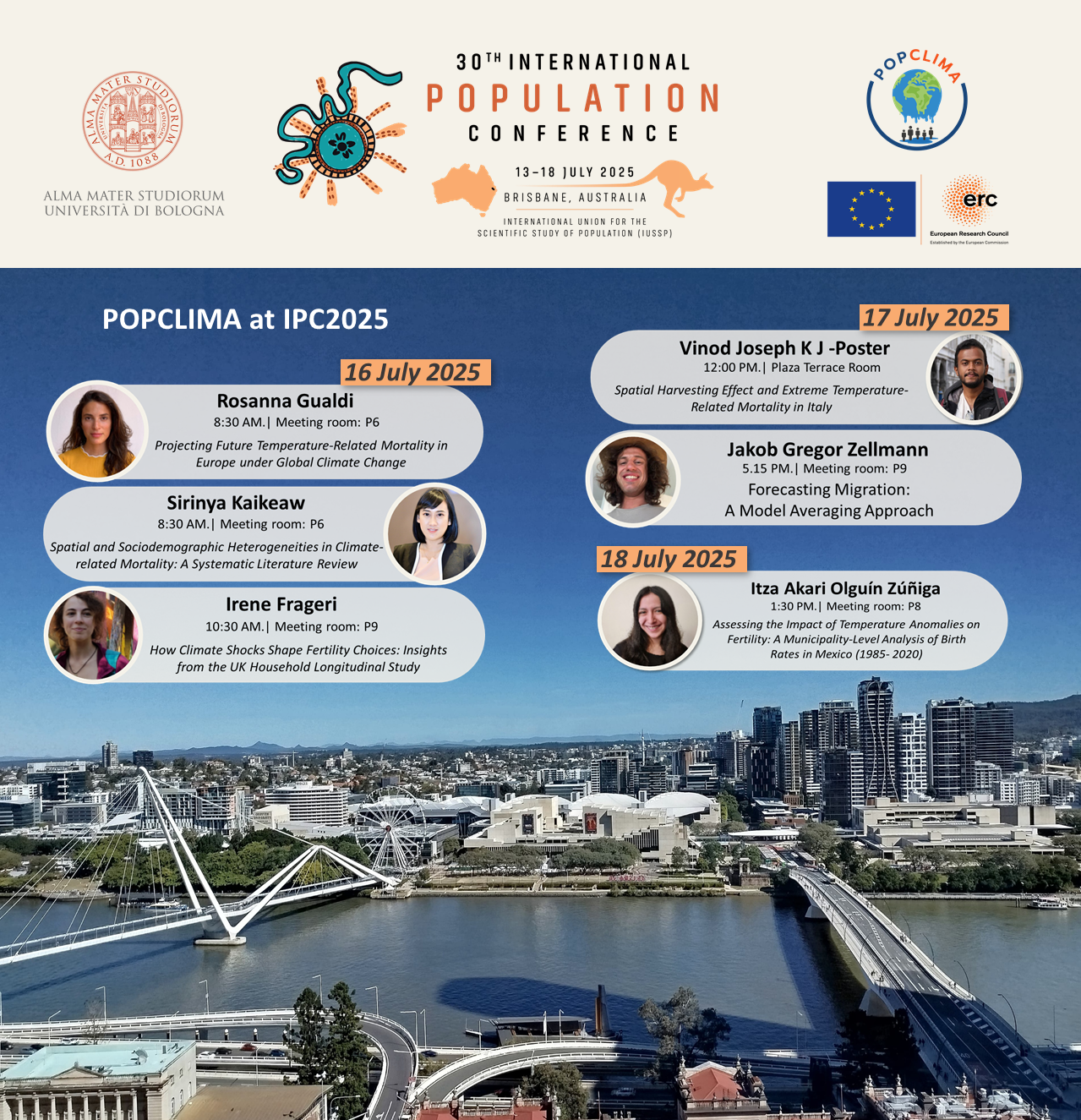
The POPCLIMA team is presenting new research on population dynamics under global climate change at the 30th International Population Conference (IPC2025) in Brisbane 13-18 July 2025. The 30th International Population Conference (IPC2025) is the world's largest gathering for population and demography research, organized by the International Union for the Scientific Study of Population (IUSSP). This in-person conference will be held in Brisbane, Australia, from July 13 to July 18, 2025, at the Brisbane Convention & Exhibition Centre (BCEC). It aims to bring together researchers, policymakers, and practitioners to discuss the latest research on a wide range of contemporary population issues. At this significant event, researchers from the POPCLIMA project will have the opportunity to present and discuss their new research. For detailed information on the IPC 2025, please visit the event website
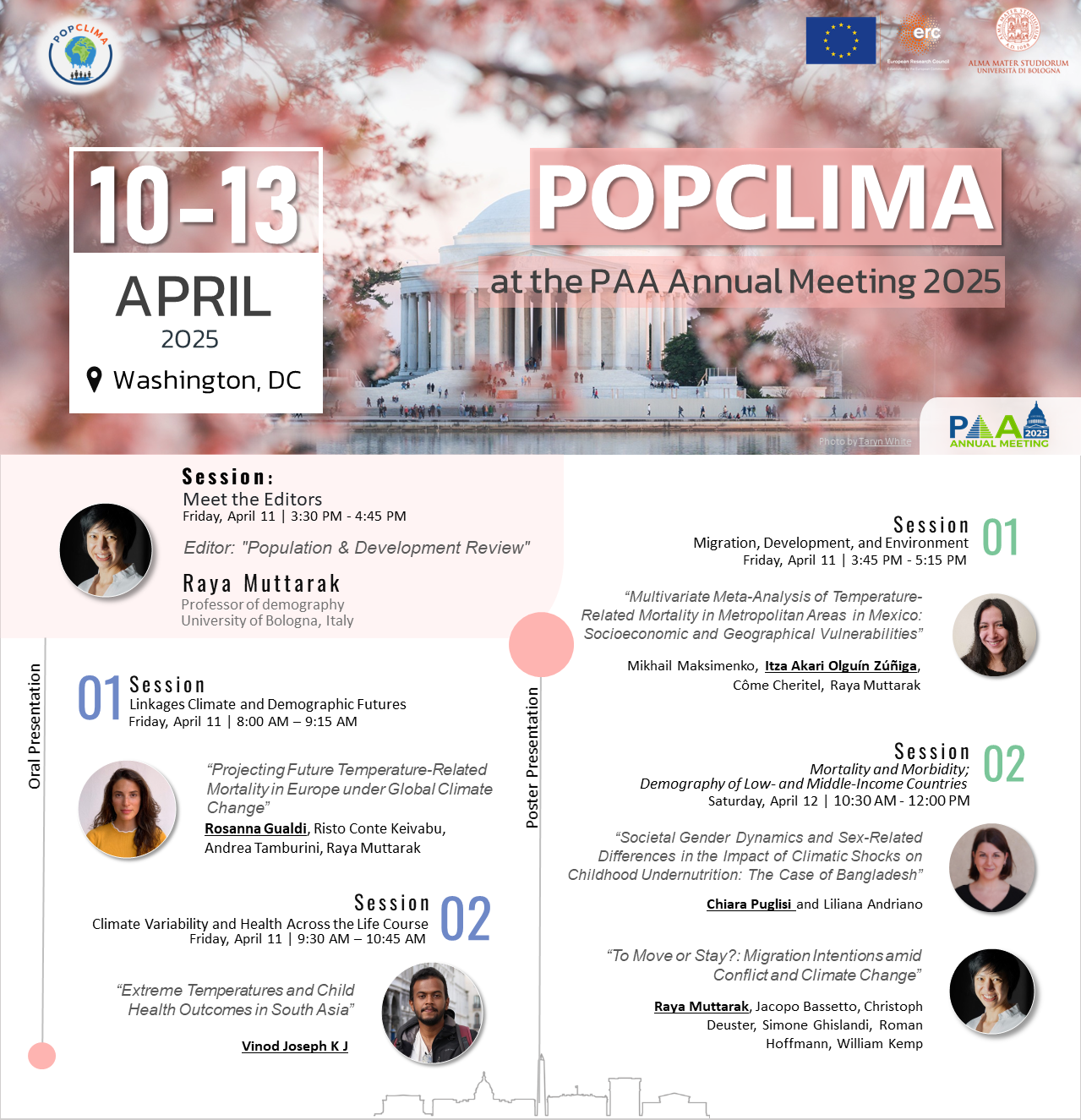
The POPCLIMA team is presenting new research on population dynamics under global climate change at the Population Association of America (PAA) Annual Meeting 2025. The Population Association of America’s annual meeting is the premier conference of demographers and social and health scientists from the United States and abroad. Here demographers at all career stages are afforded the opportunity to present their research in oral and poster sessions, hear others’ findings, and network with their peers. At this significant event, researchers from the POPCLIMA project will have the opportunity to present and discuss their new research. For detailed information to the PAA 2025 please visit the event website

The POPCLIMA team is presenting new research on population dynamics under global climate change at the European Population Conference (EPC) 2024.EAPS is a professional, non-profit organization which promotes research on population issues. As a scientific association of individual members and affiliated institutions, EAPS is a leading international and interdisciplinary forum for population studies with a special focus on Europe. Membership is open to all persons who are interested or engaged in the study of population, who support the goals of EAPS At this significant event, researchers from the POPCLIMA project will have the opportunity to present and discuss their new research. For detailed information to the EPC 2024 please visit the event website
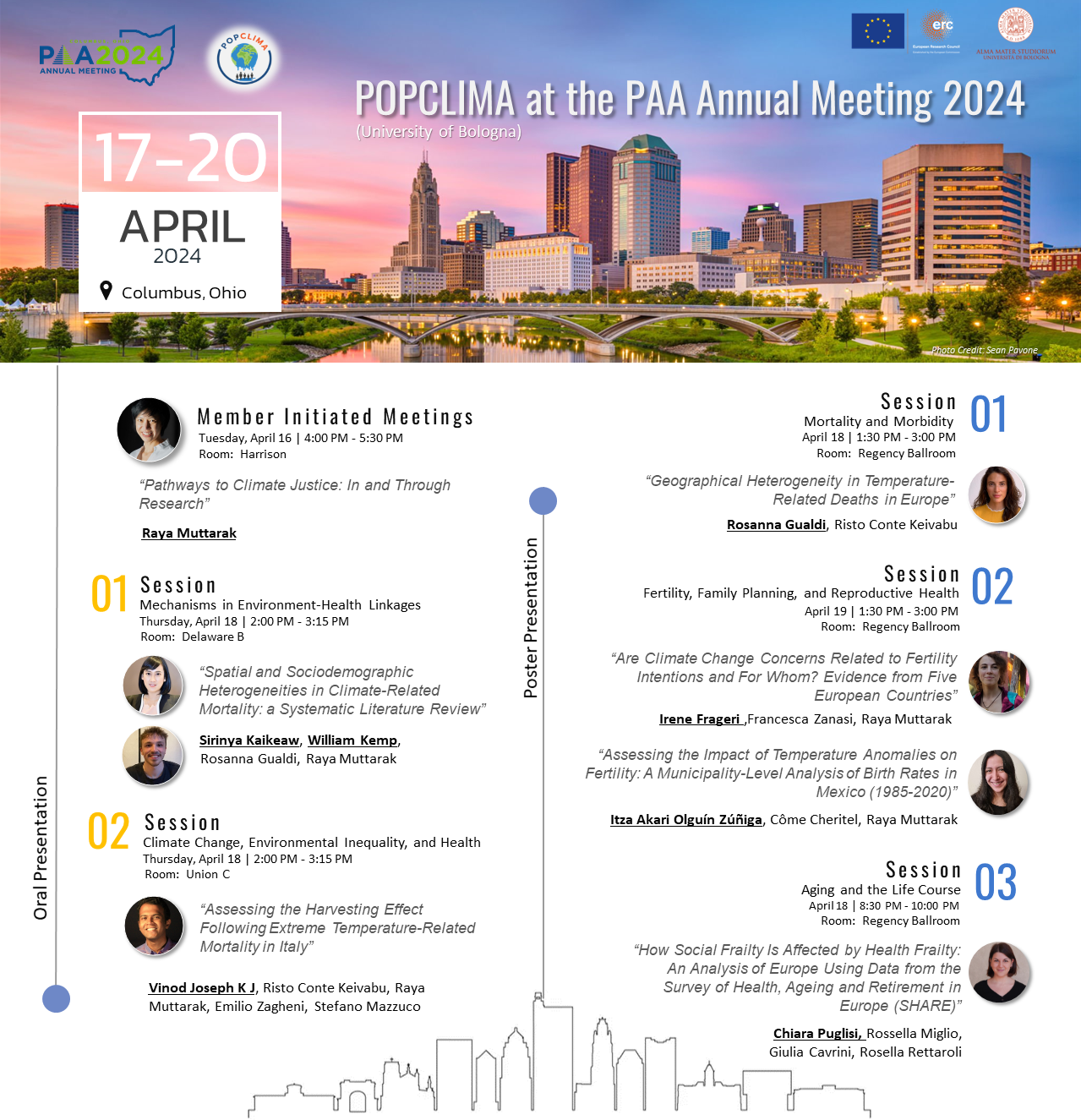
The POPCLIMA team is presenting new research on population dynamics under global climate change at the Population Association of America (PAA) Annual Meeting 2024.The Population Association of America’s annual meeting is the premier conference of demographers and social and health scientists from the United States and abroad. Here demographers at all career stages are afforded the opportunity to present their research in oral and poster sessions, hear others’ findings, and network with their peers. At this significant event, researchers from the POPCLIMA project will have the opportunity to present and discuss their new research.For detailed information to the PAA 2024 please visit the event website.
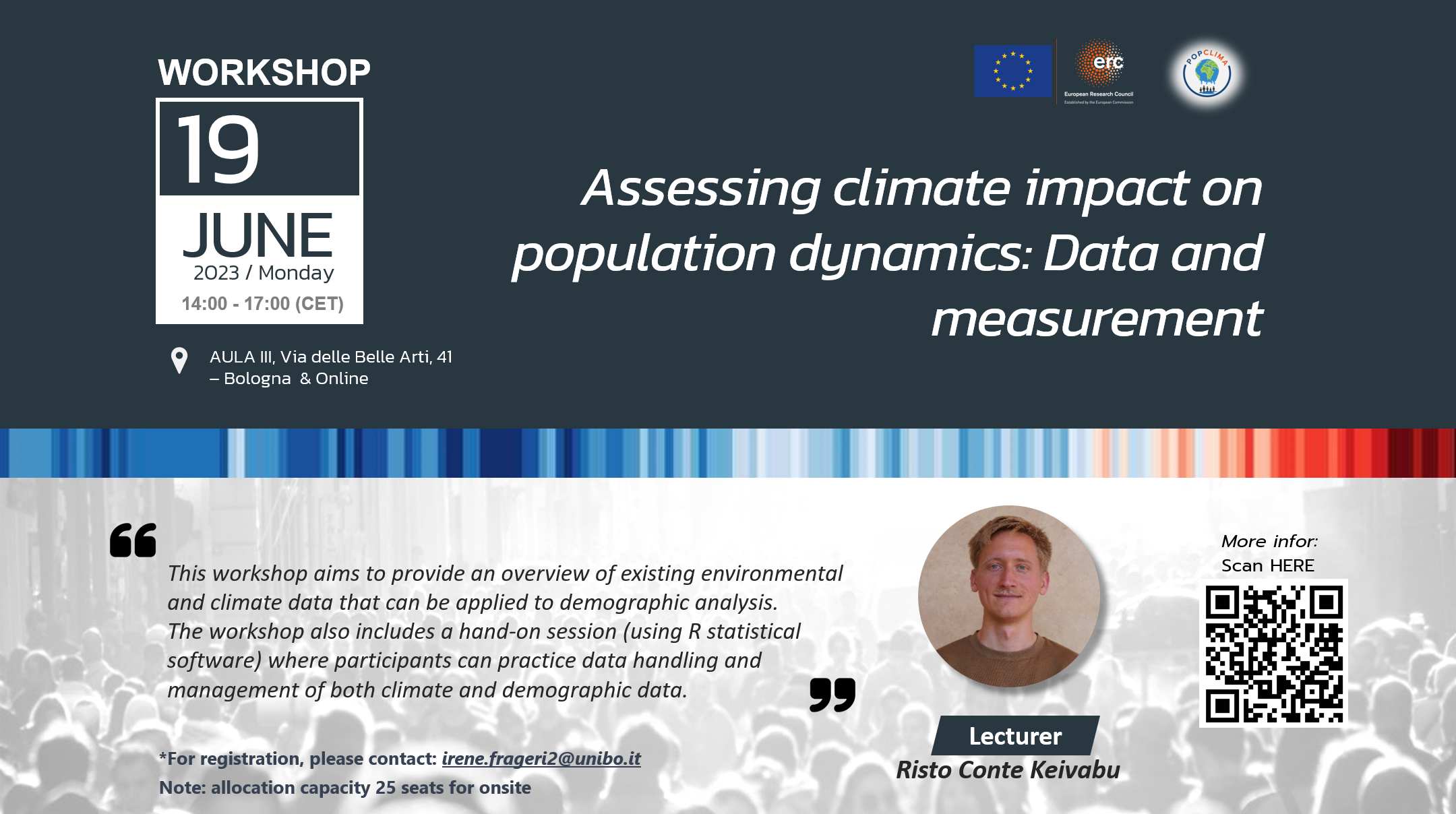
The workshop will take place on June 19th in hybrid mode: either online or in Aula III, Via delle Belle Arti 41, Bologna (14:00-17:00 CET). Lecturer: Risto Conte KeivabuThis workshop aims to provide an overview of existing environmental and climate data that can be applied to demographic analysis. The workshop also includes a hand-on session (using R statistical software) where participants can practice data handling and management of both climate and demographic data.Booking a seat onsite will be possible until the capacity of the room is reached (25 people).There is no capacity limit for online participants. For registration, please contact: irene.frageri2@unibo.itNote: allocation capacity 25 seats for onsite.
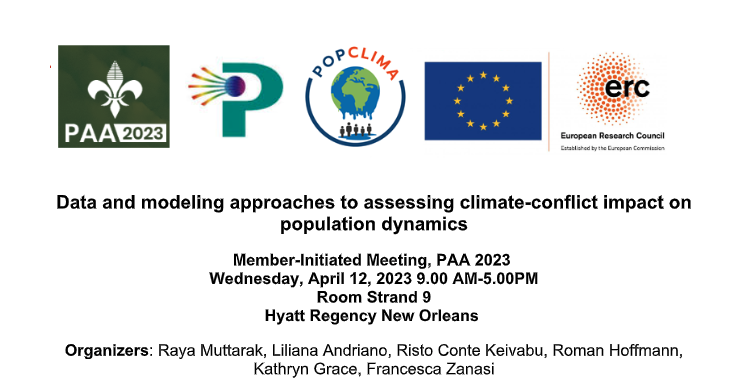
Organizers: Raya Muttarak, Liliana Andriano, Risto Conte Keivabu, Roman Hoffmann, Kathryn Grace, Francesca ZanasiThe ongoing conflicts in Ukraine, Ethiopia, Nigeria, Syria, and Afghanistan, to name a few, coupled with small- and large-scale climate change impacts (e.g., seasonal variability, extreme events, and long-term changing conditions) have the potential to strongly affect human health, well-being, livelihoods, and social systems. Climate change impacts includeextreme events with a large spatial extent like hurricanes and floods, but they also include more local experiences like drier conditions affecting crop yields, waterborne disease outbreaks or more frequent and intense heat waves. The effects of these events can be exacerbated when climate change impacts interact with conflict. As part of the activities of the IUSSP Scientific Panel on Population dynamics under global conflict and climate change, the workshop aims at providing researchers with theoretical and analytical tools to assess how conflict and climate change affect a wide range of demographic outcomes, such as health, fertility, mortality, and migration. The one-day workshop comprises four parts that reconcile theoretical approaches and hands-on activities. First, we provide an introduction to and overview of demographic research on conflict, climate change, and population dynamics. Second, an overview of the demographic, climate and conflict data sources available for research in this field, coupled with a practical session on linking spatial conflict and climate data (e.g. ACLED and ERA5 respectively) with georeferenced micro-level data (e.g. Demographic andHealth Surveys) using the software R. Third, the afternoon session will be devoted to critically approach conflict and climate change measurement, with reasoning on operationalization and causal inference. Finally, the workshop will conclude with a practical session on statistical modelling with the software R. The participation is free of charge. Please fill in the registration form: https://forms.gle/T7xqno8ZVJ1omh3k8For further information, please contact: Francesca.zanasi5@unibo.itDetailed program:Morning (9:00-13:00 with coffee break) Introduction and overview of research on climate, conflict and population dynamics – RayaMuttarak (University of Bologna)Introduction to the use of DHS data, conflict data and climate data in population research –Liliana Andriano (University of Southampton) & Risto Conte (MPIDR)Hands-on workshop – Liliana Andriano (University of Southampton) & Risto Conte(MPIDR)Lunch break (13:00-14:00)Afternoon (14:00-17:00 with coffee break)Theoretical concepts and mechanisms on climate-conflict-population dynamics nexus; How to best measure and operationalize climate effects -- Kathryn Grace (Minnesota Population Center) Methods and modeling approaches to assessing the climate-conflict impact on demographic outcomes – Roman Hoffman (IIASA) Hands-on workshop – Roman Hoffman (IIASA)Event photos:Pic 1: All the participants (for the considerable 8h effort), and all the people "behind the scenes" in the workshop at PAA2023 (12/04/2023). Fti-IpZWIAAMwpn.jpg 130.96 KBPic 2-3: The first session started with an overview of climate-conflict-population dynamics by Raya Muttarak (University of Bologna).FthUnf-WIAAr2P4.jpg 121.06 KBFthUngAXsAA-9e4.jpg 278.76 KBPic 4-5: Second session by Risto Conte (MPIDR) and Liliana Andriano (University of Southampton) with intro to climate&conflict data sources followed by hands-on lab with R.FthnxeJXgAImh3c.jpg 126.56 KBFthnxeJXgAMfSWO.jpg 163.84 KBPic 6: In the afternoon session, Roman Hoffman (IIASA) talked about conceptual measurement issues and some modeling approaches to study climate/conflict&pop dynamics.FtiWcAfWAAgz0Z1.png 420.1 KB
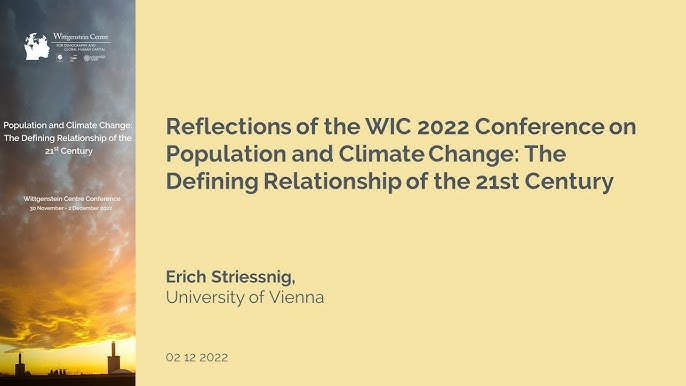
CONFERENCE VENUE & GENERAL INFORMATIONThe conference will take place in the main building of theAustrian Academy of SciencesDr. Ignaz Seipel-Platz 2, 1010 Vienna, Austria,as well as via zoom.The conference venue is centrally located and close to subway lines U1 („Schwedenplatz“ and „Stephansplatz“), U3 („Stephansplatz“ and „Stubentor“) and U4 („Schwedenplatz" and "Wien Mitte“).For your individual hotel booking we would like to make you aware of hotels with The Austrian Ecolabel.AGENDAWEDNESDAY, 30 NOVEMBER 2022CONFERENCE OPENINGVIDEO ON YOUTUBESESSION 1: CLIMATE CHANGE AND WELLBEINGSession Chairs: Sonja Spitzer, Anne GoujonLiliana AndrianoThe Effects of Heatwave on Birthweight in sub-Saharan Africavideo on YOUTUBE | short abstract | slides Risto Conte Keivabu, Francesca ZanasiExtreme Heat and Health in Old Agevideo on YOUTUBE | short abstract | extended abstract | slides Jordan D. Klein, Anjarasoa RasoanomenjanaharyClimate Change and Health Transitions: Evidence from Antananarivo, Madagascarvideo on YOUTUBE | short abstract | slides Elizabeth Fussell, Kate Burrows, Narayan SastryResearch Designs for the Study of Disaster Effects on Demographic and Health Outcomesvideo on YOUTUBE | short abstract | slidesPOSTER FLASH ONLINE:Daniela Arsenović, Stevan Savić, Dragan Milosević, Zorana Lužanin, Milena Kojić, Ivana Radić, Sanja Harhaji, Miodrag ArsićSeasonal Effect of Physiological Equivalent Temperature on Cardiovascular and Respiratory Hospital Admissions in Novi Sad (Serbia)video on YOUTUBE | short abstract | extended abstract Johan Junkka, Maria Hiltunen +++ WIC 2022 POSTER AWARD +++Temperature and Seasonality Related Infectious Disease Mortality Among Infants. A Retrospective Time-Series Study of Sweden, 1868-1892video on YOUTUBE | short abstract | poster SESSION 2: CLIMATE CHANGE AND MORTALITYSession Chairs: Risto Conte Keivabu, Andrea TamburiniMikhail Maximenko, Sergey Timonin, Natalia ShartovaSpatial Patterns of Excess Mortality Related to 2010 Heatwave in European Russia video on YOUTUBE | short abstract | slides Dariya Ordanovich, Aurelio Tobias, Diego Ramiro-FariñasThe Burden of Heat-Related Mortality in Madrid: A 130 Years Journeyvideo on YOUTUBE | short abstract Dariya Ordanovich, Aurelio Tobias, Diego RamiroTemporal Variation of the Temperature-Mortality Association in Spain: A Nationwide Analysisvideo on YOUTUBE | short abstract | slides Tamás HajduClimate Change and the Mortality of the Unbornvideo on Youtube | short abstract | slidesKEYNOTE 1Chairs: Shonali Pachauri, Jonas Peisker, Andrea TamburiniKristie L. Ebi, The Center for Health and the Global Environment (CHanGE), University of WashingtonClimate Changes Healthvideo on YOUTUBE short abstract FESTIVE EVENTFestive Event on the occasion of the publication of the latest report of the Wittgenstein Centre for Demography and Global Human Capital (WIC), a Collaboration among IIASA, OEAW and the University of Vienna, and the upcoming farewell of Wolfgang Lutz as director of the Vienna Institute of Demography (VID) after twenty years at the ÖAW.OpeningChristiane Wendehorst | Member of the Presiding Committee of the OeAW Strengthening demography in AustriaWolfgang Lutz | Wittgenstein Centre (IIASA, OeAW, University of Vienna) A report on WICLandis MacKellar | International Institute for Applied System Analysis The IIASA PerspectiveAnne Goujon | Wittgenstein Centre (IIASA, OeAW, University of Vienna) Albert van Jaarsveld | International Institute for Applied System Analysis Wolfgang and 20 years at VIDAlexia Fürnkranz-Prskawetz | Wittgenstein Centre (IIASA, OeAW, University of Vienna), TU Wien THURSDAY, 1 DECEMBER 2022KEYNOTE 2Chairs: Erich Striessnig, Jonas Peisker, Andrea TamburiniLeiwen Jiang, Population Council and Asian Demographic Research InstitutePopulation, Urbanization, and Carbon Emissions – New Evidence from Empirical StudiesVideo on YOUTUBE SESSION 3: DIFFERENTIAL VULNERABILITY AND ADAPTIVE CAPACITYSession Chairs: Liliana Andriano, Raya MuttarakNicolas Choquette-Levy, Dirgha Ghimire, Rajendra Ghimire, Indra Chaudhary, Dil CK, Michael OppenheimerHow Does Heterogeneity in Social and Informational Capital Affect Nepali Farmer Climate Risk Management? video on YOUTUBE | short abstract | extended abstract | slides Michael Freiberger, Roman Hoffmann, Alexia Prskawetz Modelling Disaster Risk: Assessing the Impact of Education on Risk Behavior video on YOUTUBE | short abstract | slides Francesca Tosi, Livia Elisa Ortensi, Rosella RettaroliEstimating the Relationship Between Extreme Climate Events and Early Female Marriage in Bangladesh video on YOUTUBE | short abstract | slides Alfredo Alessandrini, Alessandra Conte, Christoph Deuster, Daniela Ghio, Anne Goujon, Fabrizio Natale, Thomas PetroliagkisExposure and Vulnerability to Climate Change and Disaster Displacementvideo on YOUTUBE | short abstract | PAPER Maya Luetke, Kathryn Grace, Elizabeth Heger BoyleThe Effect of Climate Shocks and Armed Conflict on Household Intimate Partner Violence in Burkina Faso and Kenyashort abstract POSTER FLASH ONLINE:Afeez Ayoade Adegbite, Adesanya Kehinde Kazeem, Lawal Olubanji Akanji, Agosu, Christopher Monday, Ajose Sunday OlumideSocio-Economic Determinants of Climate Change Vulnerability Impacts and Adaptive Capabilities of Residents of Riverine Communities in Nigeriavideo on YOUTUBE | poster | short abstract | extended abstract Viacheslav Lipatov, Nadira MavlyanovaDifferential Vulnerability to Floods and Adaptive Capacity in Russiavideo on YOUTUBE Adesanya Kehinde Kazeem, Adegbite Afeez Ayoade, Sebioniga-Lawal Monsurat YetundeSpatial analysis of population densities, household emissions and climate change effects on Nigeria citizensvideo on YOUTUBE | poster | short abstract | extended abstract | paperPOSTER SESSION ONSITERESILIENCE STRATEGIES AND ENVIRONMENTALLY INDUCED MIGRATION IN THE COASTAL REGIONS OF BANGLADESH: EXISTING SCENARIO AND POST-COVID IMPLICATIONS ON LIVELIHOOD AND FOOD SECURITYMehdi AzamMacquarie University, SydneyGregor C. FalkUniversity of Education FreiburgAbstract:Bangladesh’s coastal region is extremely susceptible to climate change induced natural disasters and man-made interventions that alter the local ecosystem. This study explores and analyses various internal and external factors that have an impact environmental and socio-economic change and thereby people's displacement and migration. Based on field surveys and focus group discussions with local people, the study identifies that the shift of traditional land use patterns from rice farming to shrimp culture has generated substantial environmental and socioeconomic transformation and challenges to local resilience. Reduction of household resilience has shifted away vulnerable people to move outside their origin territory ranging from one week to a maximum of twenty-eight weeks. Data from empirical research with local people from 2011, a follow-up focus group discussions and interviews in 2022 and work experiences from climate change projects implemented in this region were used. Seasonal or temporary migration is a common practice to boost household cash and savings; considered as an alternative adaptive technique or coping method for vulnerable people when regular employment isn’t accessible. The study also finds that people have little understanding of whether such changes are linked to climate change. However, they believed that man-made interventions and traditional land use changes are the main causes of the displacement and migration; climate change exacerbates the already existing problems. The situation has further worsened because of the Covid-19-induced lockdown and restrictions since seasonal migrants had to return home from the city and other locations. The growing food insecurity and natural disasters have considerably worsened the socioeconomic conditions of the local population as a result of the lack of employment options. This has now significantly and continuously boosted migration. So far governance of migration has not been effectively mainstreamed in the current policy regimes and this presents a concern. The study recommends a new transformation of an integrated land use governance mechanism that can bring people back to the self-sustaining agriculture systems, create sustainable shrimp farming, and diversify their sources of income.FULL PAPERCLIMATE STRESS AND CHILD MARRIAGE IN SOUTHWESTERN BANGLADESHAmanda CarricoDepartment of Environmental Studies, University of Colorado-BoulderCU Population Center, Population Program, Institute of Behavioral ScienceKatharine DonatoWalsh School of foreign Service, Georgetown UniversityAbstract:Early marriage (before age 18) is associated with lower educational attainment, more frequent and high-risk pregnancies, higher rates of poverty, and psychological distress for females around the world. Although early marriage is declining in some regions, economic stress resulting from climate change has the potential slow or reverse these trends. We examine this possibility using recent data collected from households in southwestern Bangladesh, a nation with one of the highest rates of early marriage in the world. Data collected from 1,412 households revealed that 14.8% of daughters married before age 15, and 46.7% between 15 and 17. The risk of marriage before age 15 increased by over 70% in years with cyclone impacts. Heat waves also corresponded with the timing of marriage, but effects were conditional upon the characteristics of the daughter’s natal household. When households were engaged in agriculture or the father had no education, the risk of early marriage decreased somewhat in years with moderate heat waves but rose sharply in years with severe heat waves. The marriages of girls between the ages of 15 and 17 were relatively unresponsive to environmental stress.GENERATIONAL CARBON ACCOUNTS: DECOMPOSING THE CARBON FOOTPRINT BY AGE TO ASSESS THE IMPACT OF AGE AND GENERATION ON CARBON EMISSIONSCǒme CheritelParis School of Economics, International Institute for Applied Systems Analysis (IIASA) Abstract:There is no broad scientific consensus on the impact of population dynamics such as population ageing on greenhouse gas emissions and consequently on global warming, due, in particular, to the lack of studies considering the decomposition of the carbon footprint on the long term. This projects thus drafts a methodology for constructing age-specific carbon accounts, i.e. a decomposition of the carbon footprint by age. First, by estimating a household consumption model, I decompose a household's consumption by types of goods and by household members. Successively with an Input-Output analysis, I estimate the carbon footprint of each category of goods and services by age group and subsequently derive a decomposition of the carbon footprint of a given country by type of goods. The method proposed is highly flexible and can therefore be applied widely. Preliminary results are provided for France, Japan, South Korea and Mexico. Moreover, this project provide early estimates of pseudo-panels of French Carbon footprint from household consumption spanning from 1979 to 2011.UNEQUAL EXPOSURE TO AIR POLLUTION: A SPATIAL ANALYSIS OF VIENNAIngrid SetzVienna Institute of Demography (OeAW), Wittgenstein Centre (IIASA, OeAW, University of Vienna)Andreas ChmielowskiUniversity of GothenburgLu MengUniversity of BayreuthViktor MausVienna University of Economics and BusinessLorenz WimmerInstitute for Advanced Studies (IHS)Abstract:Air pollution has a strong impact on the health and well-being of societies. According to the European Environment Agency, it represents the largest environmental health risk in Europe. Yet, empirical evidence shows that air pollution is neither homogeneously spread across space nor among population groups. In our analysis, we investigate the spatial relationship between NO2 exposure and the foreign minority share at a high spatial resolution in Vienna, Austria. We overcome data limitations of previous studies by combining a novel model-based data set on NO2 concentration and sociodemographic data on a 250-square meter grid in a spatial autoregressive model, controlling for contributing factors. Our results confirm a significant positive correlation between air pollution and the proportion of minorities for different spatial aggregation levels and model specifications. The findings provide evidence on the presence of environmental inequality in intra-urban spaces and emphasize the need to reduce such inequalities. A UNIFIED MODELLING FRAMEWORK FOR PROJECTING SECTORAL GREENHOUSE GAS EMISSIONSLukas VasholdVienna University of Economics and Business Abstract:Effectively tackling climate change requires sound knowledge about greenhouse gas (GHG) emissions and their sources. Currently however, there is a lack of comprehensive, sectorally disaggregated projections for GHG emissions. Here, we project sectoral emissions for a global sample of countries and five main sectors in the horizon ranging until 2050 in a unified framework using Bayesian methods. We show that without concerted policy efforts global GHG emissions increase strongly but also highlight a number of important differences across countries and sectors. Emission increases in emerging economies are driven by strong output and population growth, with energy-related emissions accounting for most of the growth. Advanced economies are expected to reduce GHG emissions over the coming decades in the majority of sectors; transport emissions, however, are often still increasing. Our predictions align with projections from Integrated Assessment Models on a global level, but show some deviations on the regional level. THE ENERGY MIX: UNDERSTANDING PEOPLE’S DIVERGING ENERGY PREFERENCES IN BELGIUMHanne DallenesRobbe GeertsFrédéric VandermoereGerlinde VerbistUniversity of Antwerp Abstract:In this study, we aim to enhance the understanding of the interconnectedness between energy transitions and social equality by examining how social characteristics determine the composition of individual’s preferred energy mix. Previous studies about energy preferences have been mainly limited to the exploration of preferences for one energy system in isolation. Hence, little is known about how various energy sources are combined into various energy mixes. Against this background, we use Belgian data from the European Social Survey (N=1766) to examine the diversity in preferred energy mixes among individuals. Specifically, a latent class analysis is conducted to cluster the Belgian respondents into meaningful groups related to their preferred energy mix. The results suggest that there are four groups regarding preferred energy mixes. The findings emphasize that a focus on energy mixes provides a more nuanced understanding of individuals’ energy preferences as it reveals several inconsistencies and trade-offs. More specifically, the results imply that while most of the Belgian respondents prefer a carbon free energy mix, many face structural barriers that prevent them from denouncing unsustainable energy sources such as fossil fuels. The findings highlight the importance of focusing on energy mixes from a conflict-based stance as it provides an excellent tool to uncover the injustices underlying an energy transition. The article concludes that energy policies cannot be successful without addressing the justice dimension of energy transitions.EXTENDED ABSTRACTHOUSEHOLD COMPOSITION EFFECTS ON ELECTRICITY CONSUMPTION IN THE US AND BRAZILAugusto F. J. Schmidt, Roberto L. do CarmoUniversity of CampinasAlbert EsteveUniversidad Autónoma de Barcelona Abstract:Solutions presented to combat climate change often call on individual changes on consumption. Environmental problems are associated with population growth, but such focus on the macro perspective has overshadowed other aspects of societal changes that also influence consumption. Demography, like no other social science, is equipped with exploring the tendencies to those complex problems. We look at energy consumption using data from the US (Residential Energy Consumption Survey - RECS) and Brazil (Brazilian Household Budget Survey - POF in Portuguese) to understand energy consumption and changes in household composition. Due to the effects of scale, those households with fewer members have higher per capita consumption. The process associated with the second demographic transition (SDT) in the two countries are at distinct stages. To investigate the effect of household size, age, gender and race, we apply decomposition techniques proposed by Kitagawa (1995) to discuss the effect of the composition of households.EXTENDED ABSTRACTINTERSECTING INEQUITIES IN ENERGY CONSUMPTION, DECENT LIVING STANDARDS AND RISK OF CLIMATE CHANGE EXPOSURE IN GHANA, INDIA, AND BRAZILSetu PelzShonali PachauriCaroline ZimmInternational Institute for Applied Systems Analysis (IIASA)Highlights:We combine consumer expenditure microdata over two time periods from Brazil (2002/2017), Ghana (2005/2017) and India (2004/2011) with a spatial climate exposure dataset (SSP2, 1.5dC, 2030)We show that poorer households face either limited access to clean energy sources or unaffordable supply once this improves.We show that the same households are likely deprived of multiple dimensions of Decent Living Standards (DLS), highlighting heterogeneity across these.Our work then identifies intersecting inequities, both spatially and by income level, of climate change risk, DLS deprivation and energy unaffordability.Abstract:Literature linking residential energy consumption, human development and climate change risk is growing but is largely concentrated at the aggregate level. We combine consumer expenditure microdata for two time periods from Brazil (2002/2017), Ghana (2005/2017) and India (2004/2011) with a spatial climate exposure dataset (SSP2, 1.5dC, 2030) to identify intersecting inequities across the income distribution and across space. We first describe the dual challenge of energy access and affordability among poorer households and extend this analysis to include private mobility, identifying dramatic and consistent shifts towards private mobility fossil fuel consumption among the upper deciles. Second, we operationalize the decent living standards, a multi-dimensional measure of human wellbeing, across the income deciles. This highlights the strength of this framework in identifying deprivations among poorer households using standard publicly available microdata. Thirdly, we link achievement of decent living standards with climate risk, identifying both spatially and by income level an acutely vulnerable population requiring climate adaptation policy support.EXTENDED ABSTRACTEMISSIONS AND FERTILITY LOSS IN DEPOPULATION COUNTRIESKlaus PrettnerVienna Institute of DemographyVienna University of Economics and BusinessAlexia Fürnkranz-PrskawetzVienna Institute of DemographyTU WienMichael KuhnInternational Institute for Applied Systems Analysis (IIASA)Martina SiskovaVienna Institute of DemographyVadim KufenkoUniversität Hohenheim, StuttgartAbstract:In this paper we study the effect of decreasing fertility on carbon emissions in depopulation countries. The depopulation countries are currently experiencing both strong out-migration trends accompanied by significant losses in fertility. Hence, we expect emissions to be affected differently in countries experiencing depopulation compared to non-depopulation countries. There are various channels through which fertility impacts emissions, namely: the population size, the age structure of said population, as well as economic output. To analyze this issue empirically, we constructed a database from 1950 to 2015, in order to estimate the elasticities of emissions with respect to population as well as with respect to income per capita. Studies to date found that the elasticity with respect to population is much larger than the elasticity with respect to income per capita. However, we expect to find that the disparity between the two elasticities expands when restricting the database to the subsample consisting of depopulation countries only. Our contribution to the current literature lies not only in extending the available dataset and inclusion of more variables; but predominantly, in focusing on depopulation countries. For, these countries are of particular interest as they face a situation that is quite unique as it pertains to their economic and demographic structures. DOES AN AGEING SOCIETY CHALLENGE THE ENVIRONMENT? PROJECTED AGE-SPECIFIC CONSUMPTION FOR GERMANY AND ITS ECOLOGICAL FOOTPRINTHannes Mangelsdorf, Luca RebeggianiFOM UniversityJana StöverKiel UniversityChristina WilkeFOM UniversityAbstract:Population ageing and keeping the impact economic activity within planetary boundaries are two of the main future challenges of today’s societies. To measure the pressure that we as human beings exert on nature, so-called material footprints can be used. These differ depending on individual consumption which again varies with age, reflecting an individual’s situation across the life cycle. Against this background, we combine data from three different sources, namely population projections, age-specific consumption profiles and footprint data, to derive material footprints by age group and consumption category for different population scenarios for Germany. The results from our paper will add empirical evidence on how population ageing is likely to affect pressure on the environment in Germany. GENDER(ED) PATTERNS DURING HEAT WAVES: EVIDENCE FROM AUSTRIAAndrea E. SchmidtFelix DurstmüllerKatharina BruggerCompetence Centre for Climate and Health, Austrian National Public Health InstituteAbstract:Background: Due to climate change, average temperatures are rising across Europe, which also has severe effects on the whole population. While men have higher incidence of heat strokes in Austrian hospitals, women tend to report higher perceived heat exposure and more concerns about climate change, also related to their family and relatives. Yet, research on the gender patterns underlying climate change adaptation is scarce. This study aims to address this gap.Objective: We aim to identify gender-related differences in perceived heat exposure in Austria. We hypothesise that family situation and housing conditions are gendered determinants of subjective heat exposure.Data and methods: We estimate an binomial logistic regression model from the Austrian microcensus data 2019 on environmental behaviour and environmental conditions. Our dependent variable is perceived heat exposure (low/medium vs. high).Results: Our results show heterogeneous findings for men and women, with women overall displaying family situation to be a determinant of perceived heat exposure, while for men housing conditions significantly determine perceived heat exposure. Further influencing factors are the highest educational attainment (for men) and the degree of urbanisation of one’s place of living.Conclusions: More research is needed to understand gendered patterns of climate change adaptation and draw conclusions on gender-specific measures (e.g. targeted heat action plans) for men, women, and families in the context of climate change.THE ROLE OF REMOTE SENSING DATA IN MITIGATION OF THE IMPACT OF ESTABLISHMENT AND DEVELOPMENT OF REFUGEE CAMPS ON THE NATURAL ENVIRONMENT - EXAMPLES FROM BANGLADESH AND TANZANIAKarolina Sobczak-Szelc, Dominik Wach, Magdalena ChułekCentre of Migration Research University of WarsawJörg Haarpaintner, Astrid EspegrenNORCE - Climate and Environment and Health & Social Sciences , Norwegian Research Centre ASEwa Gromny, Małgorzata Jenerowicz-Sanikowska, Sebastian AleksandrowiczSpace Research Centre of the Polish Academy of SciencesAbstract:The construction and operation of the forced migrants’ settlements have a significant impact on the surrounding natural environment. Issues such as the construction and organisation of such mass refugee settlements, the relations between people living in these camps, and the natural environment seem to be crucial and can impact changes in the local and regional environment. In many countries of the Global South, like Bangladesh or Tanzania, forced migrants living in refugee settlements have limited access to basic resources and rely on humanitarian support. Lack of drinking water, food, or firewood forces them to seek these assets in the surrounding area, which can lead to the degradation of the natural environment and conflicts with the local communities. The aim of this article is to present the most essential forms of refugee activities that can stimulate changes in the natural environment. The research was conducted within the ARICA A multi-directional analysis of refugee/IDP camp areas based on HR/VHR satellite data project in the Kutupalong-Balukhali camp in Bangladesh and the Mtendeli camp in Tanzania. The results are based on a combination of remote sensing data and social qualitative data. More specifically we have carried out a literature review, conducted focus groups and in-depth interviews with experts and local actors as well as in-depth interviews with camp inhabitants and, combined this with satellite data analysis.The results show the strong influence of the establishment and development of the camp on the changes in the environment. Through investigation of camp inhabitants' and members of the host society’s perception and use of the environment within the camp area and in the surroundings of the camp, and how this has changed over time, we will develop recommendations for future camp management.EXTENDED ABSTRACTHOW WEATHER AND CONFLICT SHOCKS AFFECTED INTERNAL DISPLACEMENT IN SOMALIA DURING THE 2016/17 DROUGHTLisa ThalheimerSchool of Geography and the Environment, University of Oxford, UKPrinceton School of Public and International Affairs, Princeton University, USAMoritz P. SchwarzSchool of Geography and the Environment, University of Oxford, UKFelix PretisDepartment of Economics, University of Victoria, CanadaAbstract:Extreme weather and conflict may drive displacement. However, their individual contribution to displacement is not fully understood due to challenges around isolating channels of causality. We use disaggregated data on internal displacement in subregions of Somalia from 2016-2018 broken down by reported displacement reason and combine it with weather and conflict data. This allows us to isolate the effects of extreme weather and conflict on displacement, as well as the effects of displacement on conflict itself. We find large non-linear effects of weather on displacement where an increase in temperature anomalies from 1°C to 2 °C leads to a ten-fold increase in displaced people, and a reduction in precipitation from 50mm to 0mm leads to around a four-fold increase in displacement. We find significant effects of conflict events on displacement (which are masked when the data is aggregated). Displacement itself has little detectable effect on the occurrence of conflict events.ASSESSING FUTURE VULNERABILITIES: A MACHINE LEARNING APPROACH TO MULTI-DIMENSIONAL POPULATION PROJECTIONS AT THE SUB-NATIONAL LEVELAndrea TamburiniVienna Institute of Demography (OeAW), Wittgenstein Centre (IIASA, OeAW, University of Vienna)Abstract:Improving our understanding of future risk from climate change requires realistic projections of future populations, both in their size and distribution. Distribution can refer to the geographic breakdown, as well as the breakdown by important characteristics, such as age, sex or educational attainment. While where people will live determines exposure to hazards, population characteristics co-determine the degree of vulnerability and capability to adapt to changing environmental conditions. Despite the importance of these factors, there remains a paucity of population projections (or disaggregations thereof) at the sub-national level. We develop a machine learning-based model to produce age-, sex- and education-specific population projections at the sub-national NUTS-2 level for 34 European countries based on the Shared Socioeconomic Pathways (SSPs). Our focus on Europe is indicated by the high degree of spatial variability, both in terms of climatic conditions and population structure, as well as the rapid pace of climate change there.MODELLING INTERNATIONAL MIGRATION BY MEANS OF STOCHASTIC EVOLUTIONKarim ZantoutJacob SchewePotsdam Institute for Climate Impact Research (PIK)Member of the Leibniz Association, Potsdam, GermanyAbstract:International migration is a complex human phenomenon with multifaceted determinants that make it difficult to identify precise mechanisms. In addition, the lack of consistent highresolution data poses another dimension of uncertainty. Nevertheless, there is a need for self-consistent, dynamic models of international migration, since climate change is considered to have an impact on migration [1, 2] and well-founded projections are essential for developing adaptation and mitigation strategies.Here, we present a new model for international migration forecasts that is based on discrete time stochastic evolution. This approach combines the strengths of proper population flow accounting in terms of evolution equations while incorporating determinants of migration in stochastic parameters. More precisely, we combine the deterministic element of evolution equations with non-deterministic effects for those variables that are typically difficult to assess or to measure. Apart from direct migration flows between origin and destination countries we discuss the effect of assimilation, transit migration and return migration. Consequently, the model contains not only dynamics at different time scales but also geographical, economic, demographic, social, and political dependencies. As a proof of concept, we study model systems and compare to the commonly used Gravity Model [3, 4] pointing at crucial differences between the two formalisms. The importance of time dynamics for future projections is highlighted and possible pathways for including Climate Change effects are presented.EXTENDED ABSTRACTSESSION 4: CLIMATE CHANGE AND MIGRATIONSession Chairs: Roman Hoffmann, Patrick SakdapolrakStefan Borsky, Alexander MarblerRural Water Availability and the Growth of Citiesvideo on YOUTUBE | short abstract | slides Fabien Cottier, Wolfram Schlenker, Elisabeth Ilboudo Nébié, Richard Seager, Sonali McDermid, Michael J. Puma, Weston Anderson, Alex de Sherbinin, Andrew ReidCrop Price Variability, Environmental Change and Intra-Regional Migration in Africashort abstract Katharine Donato, Amanda Carrico, Leslie Valentine, Carol Wilson, Kimberly Rogers, Laura CaronErosion, Accretion and Migration in Bangladesh Brian Thiede, Abbie Robinson, Clark GrayClimatic Variability and Internal Migration in Asia: Evidence from Integrated Census and Survey Microdatavideo on YOUTUBE | short abstract | slides | paper Kathleen Hermans, Juliane Groth, Charlotte Wiederkehr, Patrick SakdapolrakReciprocal Linkages Between Environmental Change and Migration: Lessons from EthiopiaVideo on youtube | short abstract | slides